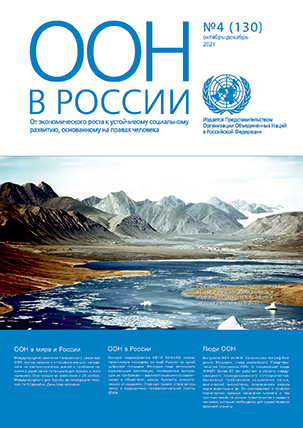9.11.2010 UNDP launched the 2010 Global Human Development Report in Moscow
The United Nations Development Programme launched in Moscow the 20th anniversary edition of the Human Development Report (HDR) 2010 titled The Real Wealth of Nations: Pathways to Human Development. The Report analyses the achievements and challenges in the area of human development in 135 countries over the last 40 year; the main trends in the Human Development Index (HDI) change; specific development problems of countries with high HDI; and the reasons for HDI decrease in some developing countries.
Among the main conclusions of the Report is that human development achievements are possible even without fast growth, particularly due to technological gains and changes in societal structures. Importantly, the poorest countries often show the largest gains. The report also demonstrates enormous diversity of experience in human development, even from similar starting points. It casts new light on the major challenges persisting even in countries with good overall gains in human development.
The Report introduces three new analytical instruments: the Inequality-adjusted HDI (IHDI), the Multidimensional Poverty Index (MPI), and the Gender Inequality Index (GII). A new methodology for HDI calculation, which reflects the current state of global development, is presented in the Report. For instance, standard of living is now measured by Gross National Income (GNI) per capita instead of GDP per capita.
It is symbolic that the Report was presented at the Economics Faculty of Moscow state University with participation of Vasily Kolesov, Dean of Economic Faculty. “The faculty remains a leading institution in integrating Human Development principles into policy making inside and outside of Russia”, said Frode Mauring, UNDP Resident Representative in Russia, in his opening remarks. “It pleases me to note that we work together on a possibility of establishing the Human Development Centre under its aegis. This would give a new boost human development in the region and provide access to relevant Russian expertise to other countries, in particular CIS countries.”
Kori Udovicki, UNDP Regional Director for Europe and the CIS, opened the discussion, underlining that: “Today’s launch occurs in a city that is at the centre of the region, marking yet another 20th anniversary - that of the onset of transition. On the one hand, Russia is special because of its size and geopolitical weight. And on the other hand, as regards human development, the political, economic, and social transitions that it has experienced during the last two decades, largely exemplify those of the countries of the region.”
Elaborating on the conclusions of the report, in particular referring to Eastern Europe and CIS countries, Tim Scott, Policy Specialist of Human Development Report Office at UNDP New York, noted: “We can clearly see that trends have not always been positive and the diversity in the region is striking. Overall, the countries of Eastern Europe and Central Asia have made positive, if modest, advances as measured by HDI relative to their starting points in 1970.
As for Russia, it now belongs to the group of High Human Development countries. It comes in at 65th out of 169 countries, directly ahead of Kazakhstan at 66th and Ukraine at 69th. Since 2005, its ranking has moved up three places. And like many of the countries in the region, it’s taken several years for its Human Development Index to recover from the impact of the transition.”
According to the UNDP expert, in 2010, HDI value for Russia is the first year higher than it was in 1990. These trends are driven partly by changes in Gross National Income, which has increased by 12% over this period of time, and also by changes in life expectancy. “At 67.2 years, Russia has one of the lowest life expectancies in the region and it is also lower now than the country’s life expectancy reported in 1970.”
The latter is what Vladimir Echenique, Deputy Dean of Economic Faculty of Lomonosov State University, focused on, commenting on Russia’s progress in human development. The expected mortality rate among men is particularly high. A comparison of statistical data for 2004 and 2008 shows an improvement, but still 397 men out of 1,000 will not live till 60. “The problem remains unresolved. And what is worrying is that external courses (various accidents) are a number two factor in this after cardio-vascular diseases,” Vladimir Echenique pointed out.
The Human Development Reports, commissioned annually by the United Nations Development Programme since 1990, are editorially independent from UNDP. Each of the reports rates countries in accordance with the Human Development Index. The index measures national development not simply by economic growth but by health and education indicators.
As UNDP Regional Director, Kori Udovicki, also mentioned, “the human development paradigm has laid the foundation for the Millennium Development Goals, and many other ideas that are now part of the development mainstream. It has influenced an entire generation of policy makers, thinkers, and development practitioners, both within and beyond the United Nations.”
The 2010 Global Human Development Report The Real Wealth of Nations: Pathways to Human Development was launched by Secretary-General Ban Ki-moon, UNDP Administrator Helen Clark, and Nobel laureate Amartya Sen in New York on 4 November.
The full text of the Report and additional materials can be found at: hdr.undp.org
 Participants of the Human Development Report Presentation at Economic Faculty of Moscow State University
Participants of the Human Development Report Presentation at Economic Faculty of Moscow State University
|
 КKori Udovicki addresses the audience, opening the discussion of the Report
КKori Udovicki addresses the audience, opening the discussion of the Report
|
 Frode Mauring, UNDP Resident Representative
Frode Mauring, UNDP Resident Representative
|
 Presidium of the forum. Tim Scott, UNDP expert, presents the Report
Presidium of the forum. Tim Scott, UNDP expert, presents the Report
|

